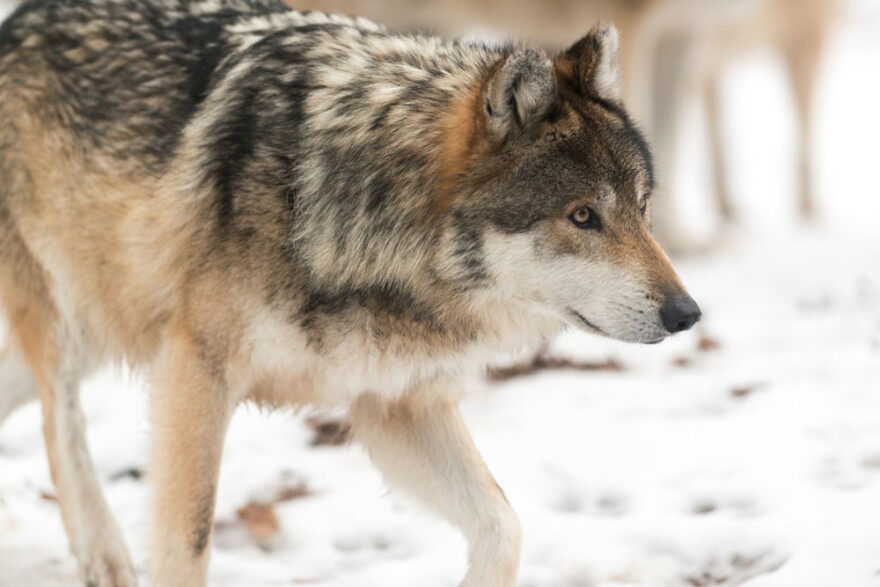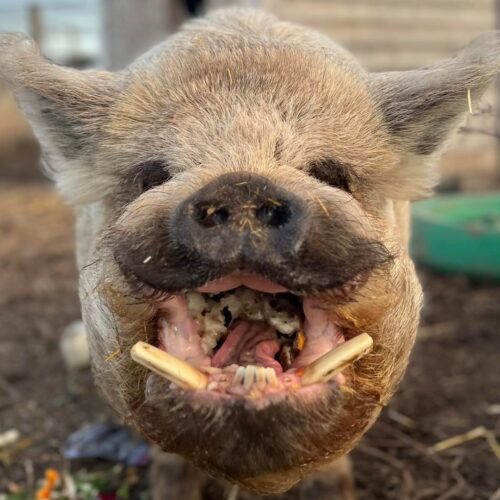
Lethal Removal, Range Rider Concerns Raised At Washington Wolf Advisory Group Meeting
Listen
Read
For the first time, a wolf wearing a radio collar has crossed south of Interstate-90 into Washington’s southern Cascade Mountains, biologists with the Department of Fish and Wildlife announced at a Wolf Advisory Group meeting.
During the meeting Thursday, biologists described the path of the wandering wolf. Wolves previously traversed south of I-90. However, this is the first time state biologists can track a wolf’s movements in the area, which could help the state inch closer to its wolf recovery goals.
Initially the wolf crossed I-90 east of Cle Elum, said Ben Maletzke, statewide wolf specialist for the Washington Department of Fish and Wildlife.
“He’ll have a better chance of finding other wolves down there than we will. They kind of have a sense for that,” Maletzke said.
The department will continue monitoring the wolf’s movements, Maletzke said, especially because biologists don’t know where the wolf will end up.
“He could be in Oregon or even up to B.C. in another week or two,” Maletzke said.
Gray wolves were wiped out in Washington by the 1930s. In recent years, the state documented its first breeding pair in 2008, after wolves traveled to Washington from neighboring states.
In Washington, wolves are protected under the state Endangered Species Act. Gray wolves were removed from the federal Endangered Species List on Jan. 4, 2021.
The state recovery plan divides the state into three distinct regions. There are two options where the state will consider wolves recovered.
In a consecutive three-year scenario, four separate breeding pairs would live in each recovery region, with three additional breeding pairs anywhere in Washington.
In a yearlong scenario, four separate breeding pairs would live in each recovery region, with six additional breeding pairs anywhere in Washington.
This newest traveling wolf could help further the recovery goal for the region that encompasses Washington’s Southern Cascades and Northwest Coast.
Recent snow will help biologists conduct a year-end, minimum wolf count for 2021. The most recent figures from 2020 found at least 132 known wolves in 24 known packs including at least 13 breeding pairs. The Confederated Tribes of the Colville Reservation reported at least 46 wolves in five packs.
In 2021, a new pack of wolves attacked livestock in southeastern Washington, after which Washington Department of Fish and Wildlife Director Kelly Susewind authorized the lethal removal of two wolves from the pack. Department staff believed the pack had four adults and four pups.
Two wolves were killed as a result of the lethal removal order. Around the same time, one vehicle hit a wolf on a gravel backroad; another hit a wolf on a remote county road, both in Columbia County, Maletzke said.
However, conservation groups questioned the need to kill the second wolf in the pack, after the department killed an adult male wolf and vehicles struck two other wolves.
“Taking four wolves out of a pack, that’s a big impact,” said Paula Swedeen, policy director for Conservation Northwest and a member of the Wolf Advisory Group. “The original intent was to take out one to two wolves, and four wolves from that pack ended up dying.”
Removing four wolves could harm the structure of the pack, Swedeen said.
“It’s not a numbers game. It really is about maintaining the social integrity of the population through keeping packs as intact as possible,” she said.
At the time, the wolves continued to gather in a core livestock grazing area. The goal of lethal removals is to change pack behavior, Maletzke said. However, nothing seemed to move the wolves out of the livestock grazing area, he said.
“If lethal removal is going to be used, removing a wolf on a pasture right around the cows is probably one of the bigger impacts you can have to try and get those wolves to move out of there,” Maletzke said.
Now, the new pack appears to have moved to other areas, he said.
In the future, Swedeen said, the lethal removal protocols should account for the total number of wolves killed in each pack, whether it’s from the lethal removal order or other accidents.
In the case of the vehicle accidents, enforcement officers checked out each scene to rule out potential poaching, Maletzke said.
“There was evidence of car parts and evidence on the wolves of being hit by vehicles,” Maletzke said.
The timing of the accidents during the lethal removal order is an unusual situation, Maletzke said. However, a lot of white-tail deer get hit in the same area, where brush often clutters the edge of the road.
“Things happen. These wolves are moving across an area where there are a number of roads that people use every day,” he said. “It’s kind of a tough area for wildlife to cross and not get hit.”
Moreover, in the Blue Mountains where these incidents occurred, the Fish and Wildlife Department hasn’t been able to hire any range riders, who help manage livestock on horseback and help deter wolf conflicts. Range riders stay with the livestock and are often used to cover large areas.
Producers continually asked for a range rider for the Blue Mountain area, said Samee Charriere, a livestock producer near Clarkston, Washington, and a member of the Wolf Advisory Group.
“We’re going to have the same problems if we don’t end up with a range rider,” Charriere said. “There’s nobody that’s going to do it. That’s the bottom line here.”
The department will keep searching for someone who can ride horseback, who has a horse and a travel trailer, and who doesn’t currently have a job and can work long hours, said Joey McCanna, a wildlife conflict supervisor with the Fish and Wildlife Department.
The contracted position isn’t full time. Potential applicants also told the department the job doesn’t pay enough, McCanna said, which led the department to pay for mileage.
“In the Blue Mountains, there’s a lot of travel,” McCanna said. “If we need range riders in the Grouse Flats area, and they’re located in Walla Walla, that’s a three hour trip just to get there.”
It also helps to hire locals who know the mountains and terrain, McCanna said.
In the meantime, the department brought range riders in from other areas, such as Northeastern Washington. McCanna said he would like to have at least two Fish and Wildlife-contracted range riders in the Blue Mountains.
“We’re constantly looking for range riders,” he said.
Livestock owners on private grazing allotments also can hire range riders, and the department will share half of the cost, McCanna said.
Swedeen said she thought the state might have to find creative ways to fill its range rider program.
“It’s not that there’s a shortage, the department just hasn’t created the conditions to attract people willing to do the job,” she said.
In Northeastern Washington, Conservation Northwest helped create a grant program to help local people manage range-riders, Swedeen said. Potentially, she said, a non-profit could manage range riders in the Blue Mountains.
“That takes a willingness and a lot of organizational effort,” she said.
Without that sort of effort, she said, the department may need to pay riders more money.
“Everyone collectively throwing up their hands and saying, ‘There’s just not people willing to do it, and so we’re not going to have enough riders,’ that’s not OK,” Swedeen said.
Moreover, McCanna said the department recently had trouble sourcing other non-lethal tools to deter wolf predation, such as fladry, which are colored flags that can be tied up around smaller pastures or calving areas to scare wolves away, and foxlights, which can be used at high-use watering or salting sites.
Supply chain issues combined with vendors going out of business caused the department to scramble, he said.
Fish and Wildlife borrowed fladry from Northeastern Washington. A local company in Colfax constructed a half mile of fladry but determined it wasn’t cost effective enough to continue.
“Vendors can only make so much fladry, and there’s only so much need for it all throughout the Western states,” McCanna said.
After McCanna raised the issue at the meeting Thursday, the conservation group Defenders of Wildlife offered up another half mile of fladry. In addition, the U.S. Department of Agriculture’s Wildlife Services offered to loan the department more fladry.
“We just want to make sure we have enough fladry if we need it,” McCanna said.
Related Stories:

One woman finds healing by caring for wild animals on the Palouse
Haku the pig, a resident at Palouse Wildlife Rescue and Rehabilitation, draws lots of attention from visitors. (Credit: Ryan Law) Listen (Runtime 3:49) Read It’s dark inside this large red

Head Start programs reopen in Central Washington
More than 400 children in Central Washington are returning to their classrooms following the arrival of federal funds for Early Head Start and Head Start programs at Inspire Development Centers. The organization offers early childhood education programs to low-income children through various centers.

Federal funding cuts, freezes hit Palouse nonprofits
Palouse area nonprofits focused on helping with emergency food and the arts have had their funding frozen or cut.












